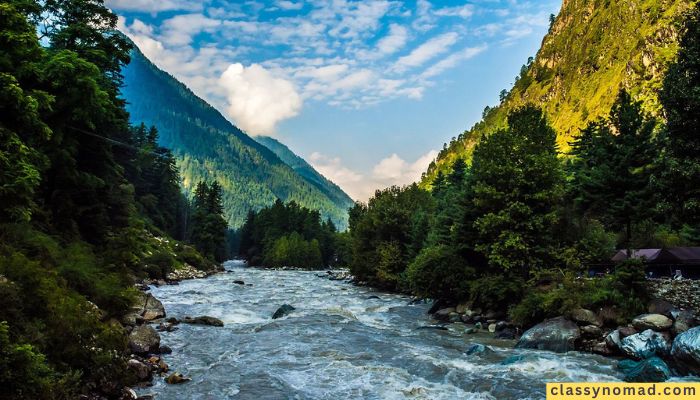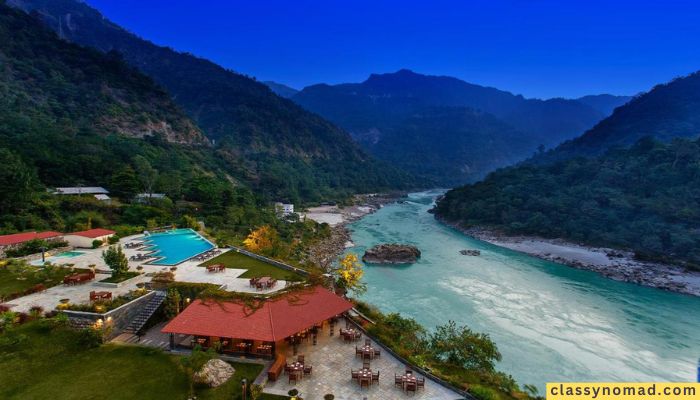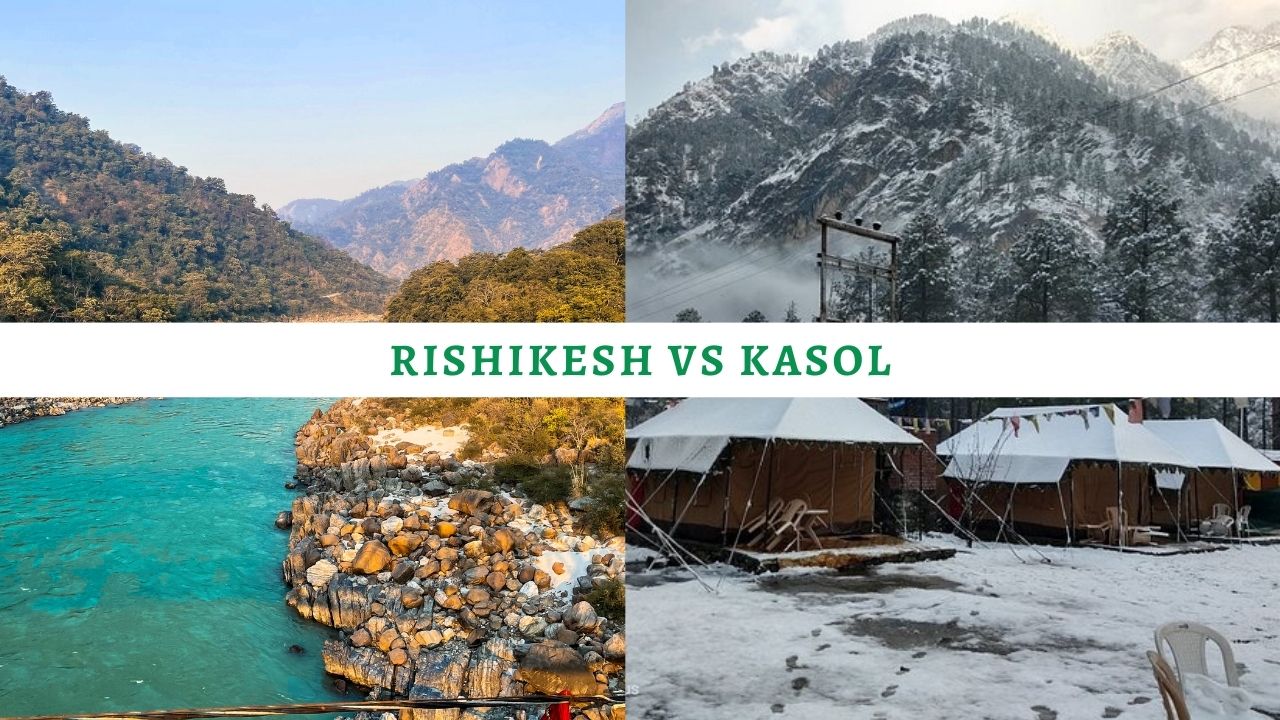In this blog post, I have talked about Rishikesh vs Kasol in various aspects. If you are confused about which one to choose as your next holiday destination, then this article will be helpful for you.
When it comes to serene retreats in the lap of nature, Rishikesh and Kasol are two destinations in India that stand out among travelers.
Nestled in the picturesque landscapes of Uttarakhand and Himachal Pradesh respectively, Rishikesh and Kasol offer unique experiences to those seeking solace, adventure, and a break from the bustling city life.
In this article, we will delve into the various aspects that set these two destinations apart, ranging from their geographical characteristics and cultural significance to the array of activities, accommodation options, and culinary delights they offer.
Overview: Rishikesh vs Kasol
Rishikesh, often referred to as the “Yoga Capital of the World,” is a spiritual haven situated in the foothills of the Himalayas. Renowned for its numerous yoga and meditation centers, Rishikesh attracts spiritual seekers and yoga enthusiasts from around the globe.
On the other hand, Kasol, nestled in the Parvati Valley, is a quaint village known for its hippie culture and breathtaking views of the snow-clad mountains. It has become a popular destination for backpackers and nature lovers seeking tranquility.
Location and Accessibility: Rishikesh vs Kasol

Rishikesh is located in the northern state of Uttarakhand, around 230 kilometers north of Delhi. It is well-connected by road and rail, with the nearest airport being Jolly Grant Airport in Dehradun, approximately 21 kilometers away.
Kasol, situated in the Kullu district of Himachal Pradesh, can be reached via a scenic road journey from Bhuntar, the nearest airport, located about 31 kilometers away.
Both destinations offer easy accessibility, with regular bus and taxi services available.
Geographical Comparison: Rishikesh vs Kasol
Rishikesh is situated on the banks of the holy Ganges River and is surrounded by lush green forests and towering mountains. The town is known for its suspension bridge, Laxman Jhula, which offers panoramic views of the river and the surrounding landscape.
Kasol, on the other hand, is nestled in the Parvati Valley, alongside the Parvati River. The valley is characterized by dense forests, gushing waterfalls, and charming villages, making it an idyllic spot for nature enthusiasts.
Historical and Cultural Significance: Rishikesh vs Kasol
Rishikesh holds immense historical and cultural significance. It is believed to be the place where Lord Rama performed penance and attained enlightenment. The town is dotted with ancient temples and ashrams, attracting devotees and spiritual seekers.
In contrast, Kasol is a melting pot of cultures, with a significant influence of Israeli settlers. The village hosts various trance music festivals and offers a glimpse into the fusion of Indian and Israeli cultures.
Natural Beauty and Scenic Views: Rishikesh vs Kasol
Rishikesh boasts breathtaking natural beauty, with the majestic Himalayas serving as a backdrop. The flowing Ganges River and the surrounding hills create a serene atmosphere, perfect for meditation and rejuvenation.
Kasol, on the other hand, mesmerizes visitors with its stunning landscapes, including snow-capped peaks, glistening rivers, and lush valleys. The Parvati River, with its crystal-clear waters, adds to the enchanting charm of the place.
Adventure and Outdoor Activities: Rishikesh vs Kasol
Rishikesh is a hub for adventure enthusiasts, offering a plethora of activities such as white-water rafting, trekking, camping, and cliff jumping. The nearby Shivpuri region is particularly famous for its thrilling river rafting experiences.
In contrast, Kasol is a paradise for trekkers, with popular trails leading to Kheerganga, Malana, and Tosh. The region also offers opportunities for camping, rock climbing, and trout fishing, allowing visitors to immerse themselves in the lap of nature.
Accommodation Options: Rishikesh vs Kasol

Rishikesh provides a wide range of accommodation options, catering to various budgets and preferences. From luxury resorts and hotels to budget homestays and ashrams, the town offers something for everyone.
Kasol, being a smaller village, primarily offers guesthouses, homestays, and campsites. These accommodations provide a cozy and rustic experience, allowing visitors to enjoy the tranquility of the surroundings.
Food and Cuisine: Rishikesh vs Kasol
Rishikesh offers a diverse culinary experience, with numerous vegetarian restaurants and cafes serving Indian, continental, and international cuisines. The town is particularly known for its Ayurvedic and organic food options, providing a healthy and nourishing dining experience.
Kasol, influenced by Israeli culture, offers a unique gastronomic journey with its cafes serving delectable Israeli dishes, along with traditional Indian cuisine and global fusion delicacies.
Nightlife and Entertainment: Rishikesh vs Kasol
Rishikesh is more renowned for its spiritual and holistic ambiance, and the nightlife is relatively subdued. However, the town has a few cafes and restaurants that offer live music performances and cultural shows in the evenings.
Kasol, on the other hand, is known for its vibrant nightlife. The village comes alive after dusk with its bustling cafes, bonfire gatherings, and occasional parties, attracting the young and free-spirited.
Shopping and Souvenirs: Rishikesh vs Kasol
Rishikesh offers a wide array of shopping options, with bustling markets selling spiritual artifacts, traditional clothing, yoga gear, and handicrafts. The town is famous for its vibrant and colorful markets, such as the Lakshman Jhula Market and the Ram Jhula Market.
Kasol, although smaller in size, offers a unique shopping experience with its flea markets, where visitors can find hippie clothing, handmade jewelry, and local handicrafts.
Tourist Attractions: Rishikesh vs Kasol
Rishikesh boasts several tourist attractions, including the iconic Laxman Jhula and Ram Jhula, which are suspended bridges across the Ganges. The Triveni Ghat, Parmarth Niketan Ashram, and Beatles Ashram are also popular spots to visit.
Kasol, on the other hand, offers scenic treks to places like Kheerganga, Malana, and Tosh. The nearby village of Manikaran, famous for its hot springs and religious significance, is also worth exploring.
Best Time to Visit: Rishikesh vs Kasol
Rishikesh can be visited throughout the year, with the months of October to March being particularly pleasant. The summer months offer a respite from the scorching heat of the plains, while the winter months provide a serene and chilly experience.
Kasol is best visited during the summer and autumn months, from May to November, when the weather is pleasant, and the landscapes are at their vibrant best.
Ideal Trip Duration: Rishikesh vs Kasol
For Rishikesh, a minimum of three to four days is recommended to explore the town, indulge in yoga and meditation sessions, and experience adventure activities.
Kasol, being a smaller village, can be covered in two to three days, allowing visitors to enjoy the scenic beauty, indulge in trekking, and soak in the peaceful ambiance.
Average Budget: Rishikesh vs Kasol
Rishikesh offers a range of accommodation and dining options to suit various budgets. On average, a budget traveler can expect to spend around $15-30 per day, while a mid-range traveler may spend $30-50 per day.
Kasol, being a relatively economical destination, offers cheaper accommodations and dining options. A budget traveler can expect to spend around $10-25 per day, while a mid-range traveler may spend $25-50 per day.
Getting Around: Rishikesh vs Kasol
In Rishikesh, most of the attractions are within walking distance, and bicycles and motorbikes are readily available for rent. Local buses and shared auto-rickshaws are also convenient modes of transport.
Kasol is a small village, and most places of interest can be explored on foot. Taxis and local buses are available for traveling to nearby villages and towns.
Conclusion – Rishikesh vs Kasol
Rishikesh and Kasol, although distinct in their characteristics, offer unique experiences for travelers seeking different flavors of retreat.
Rishikesh embraces spirituality, adventure, and natural beauty, while Kasol immerses visitors in a serene and bohemian ambiance, complemented by stunning landscapes.
Whether you seek inner peace through yoga and meditation or wish to explore the enchanting valleys and embark on thrilling treks, both destinations have something extraordinary to offer.
FAQs – Rishikesh vs Kasol
1. Can I practice yoga and meditation in Kasol?
While Kasol doesn’t have as many dedicated yoga centers as Rishikesh, some accommodations and cafes offer yoga and meditation classes. You can also practice yoga amidst nature in the serene surroundings of Kasol.
2. Is it safe to trek in Rishikesh and Kasol?
Trekking in both Rishikesh and Kasol is generally safe, but it’s advisable to go with experienced guides and trekking groups. Stay informed about weather conditions and follow safety guidelines to ensure a secure trekking experience.
3. Are there any religious festivals celebrated in Rishikesh and Kasol?
Rishikesh celebrates various religious festivals such as Ganga Dussehra and Diwali, while Kasol has a more laid-back and bohemian vibe. However, you can witness the joyous celebrations of festivals like Holi and Diwali in Kasol, with a unique blend of Indian and Israeli influences.

